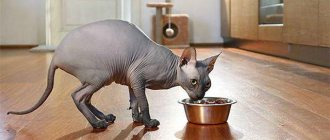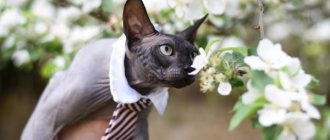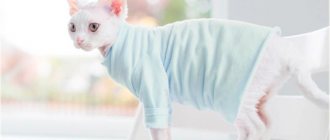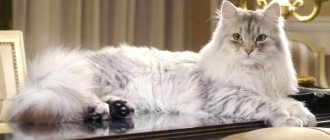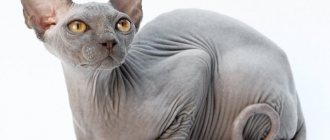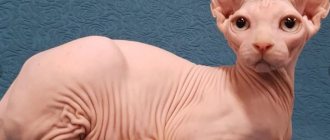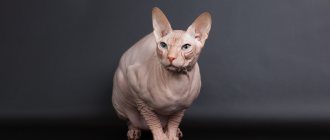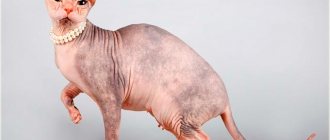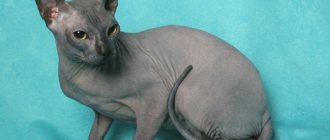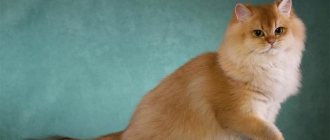Elves are unusual hairless cats with graceful movements and ears turned outward. Their exotic appearance evokes associations with the heroes of ancient fairy tales and makes you admire these cute creatures. And if you decide to get such a pet, it would be a good idea to find out how to choose the right kitten, what the standards are for this breed and the basic rules for caring for hairless animals.
Brief history of the breed
The elves were bred in the USA thanks to the dedicated work of American breeder Kristen Lead. After the death of her Sphynx pet, the woman decided to try to get similar cats that would not have a predisposition to serious hereditary pathologies.
To develop a new breed, Lead and her friend Karen Nelson decided to use Canadian Sphynxes and American Curls. The first few attempts were unsuccessful. But Lid did not lose hope and as a result received cats that resembled fairy-tale characters.
In 2006, elves were evaluated at TICA shows, and in 2007 they were given the status of an experimental breed.
Interesting Facts
In the short time the breed has existed, many interesting things have been associated with it:
- Elves are very rare and expensive cats. Since nurseries specializing in breeding the breed are concentrated in the United States, the average price of such a kitten is $1,500-2,000.
- These cats received the name “elf” due to their unusual appearance and bizarrely curved ears. And because of their resemblance to hairless Canadians, they are often called elven sphinxes.
- Due to the difficulties associated with finding a partner for mating, in some countries it is not prohibited to crossbreed Canadian Sphynxes and elves. True, kittens born from such a mating will be considered mestizos and some of them will turn out to be straight-eared.
Breeding and sterilization
Elves become sexually mature early, at 6-7 months. But it is recommended to carry out mating no earlier than one and a half years of age. Due to the fact that the breed is quite rare, there is hardly a pair for mating in Russia, even in nurseries. Therefore, to continue the family line, they choose either sphinxes (which is fraught with the appearance of genetic diseases in the offspring), or they look for a suitable partner in another country (most often the USA or Canada).
If mating an elf cat is not planned, they will be castrated or sterilized. It is recommended to carry out the procedure when the pet is 1-2 years old. The level of development of veterinary medicine allows the operation to be performed with minimal negative consequences.
Post-operative care is very important. At first, you need to ensure maximum rest in a warm, soft place on the floor, protect your stomach with a special bandage, and limit food. After the suture heals, the cat returns to its previous routine.
Breed description, standards, appearance
The Elven Sphynx is a hairless, slender cat with impressive coordination, long limbs, a graceful neck and curled ear tips.
In detail - “About breeds of cats with curled ears.”
Dimensions and weight
Elves are fairly large cats with pronounced sexual dimorphism. The weight of an adult male of this breed is 7-8 kg. The weight of an elven cat varies between 5-6 kg.
Anatomical characteristics
Ideally, an elf cat should meet the following description:
- The head is wedge-shaped, with prominent cheekbones, developed whisker pads and a flat forehead. The nose is straight, with a slight dent in the bridge of the nose. The eyebrows and whiskers are broken, and in some pets they are completely absent.
- The eyes are almond-shaped, large, slightly convex. The iris can be colored green, blue or yellow. According to the standard, heterochromia is allowed in elven sphinxes.
- Elves' ears are large, wide at the base, with curved, pointed tips. The tilt angle varies between 90-180 degrees. The stable cartilage should account for at least 1/3 of the length of the ear tissue.
- The body of an elf cat is lean, muscular, with a convex belly, which gives the elf a pear-shaped body. The neck is long, with a graceful curve. The chest is round and wide.
- The limbs are strong, slender with wide oval pads. The elf's hind legs are slightly shorter than his front ones. Because of this, it seems that the cat moves with a sneaking gait.
- The elf's tail is whip-like, long, wide at the base, with a pointed tip. At rest, strongly twisted.
Color and coat type
The body of the elven sphinx is covered with hot, thick, slightly grainy skin that feels like suede. There are pronounced folds near the shoulders, between the ears and around the muzzle. Short hairs may grow on the tail, paws, outside of the ears and the bridge of the nose, the length of which should not exceed 2 mm.
The color of the Elven Sphinx can be almost any color. The most common colors in the breed are beige, light gray, black and white. According to the standard, contrasting spots are allowed on the body of the Elven Sphinx.
Possible breed defects
Disadvantages in the presence of which the elf will not receive a high expert assessment:
- high-set ears, the angle of bend of which is more than 180 or less than 90 degrees;
- profusely pubescent body;
- rounded or grooved edge of the ears;
- the body is too massive or fragile;
- insufficient number of folds on the head;
- straight profile;
- narrowed head;
- twisted or deformed tail.
Character and temperament
The elf cat is endowed with a sociable and good-natured disposition. She quickly gets used to people and tries in every possible way to demonstrate her affection. A cat of this breed loves to be the center of attention and does not tolerate loneliness well.
On a note. Elven Sphynxes are very theatrical and mannered cats, prone to demonstrative “playing for the audience.” They can be capricious and often try to attract attention to themselves.
The Elf cat loves children very much and gets along well with kids. He is very careful in his play and is patient with children's pranks.
The sociable and friendly disposition of the Elven Sphynx allows him to easily find a common language with different pets. A cat of this breed will not conflict with either its brothers or non-aggressive dogs.
How to choose the right kitten
Elven sphinxes are not very common outside the United States. In Russia there are only a few nurseries specializing in breeding this breed. Therefore, the search for a kitten may take a long time. To speed up the process and quickly become the owner of an exotic pet, it is better to contact foreign breeders.
Before making a final decision on purchasing an Elf cat, you need to make sure that he has documents confirming his breed and vaccinations. It also doesn’t hurt to look at the behavior of the kids and the conditions in which they are kept.
It is important that the kitten you like has a slender body covered with folded skin, a convex but not bloated belly and large ears with tips curved back.
On a note. The formation of the curve of the auricle in elven sphinxes is completed by 4-6 months. Kittens are born with straight ears, the tips of which begin to curl after a few days.
Kitten care
Weaning from the mother too early can negatively affect the character and health of little elves. Therefore, responsible breeders begin giving away kittens once they are 12 weeks old. By this age, elven sphinxes eat many foods without problems, know the litter box and know how to use a scratching post.
New owners will only have to show the pet where its toilet and bowls of water and food are located.
In order for the elf kitten to quickly get used to the changed conditions, he is given more attention and care. To avoid digestive problems due to a sudden change in diet, the hairless pet is initially fed what it ate from the breeder.
New products are introduced into the cat's menu gradually, and it should be monitored to see if they cause allergies. The elf's feeding schedule depends on the pet's age:
- 3-6 months – 4-5 times a day;
- 6-12 months – 3 times a day;
- from 12 months – 2 times a day.
On a note. Little elves are incredibly inquisitive and try to get into the most inaccessible corners of the apartment.
To protect them, wires, ornamental plants, household chemicals, and fragile and small items are kept away from kittens. And to prevent the Elven Sphinx from becoming a victim of its curiosity, you need to keep the doors of ovens, washing machines and dryers closed.
Nutritional Features
The key to a cat's health is its nutrition. For feeding, we recommend purchasing 3 bowls: one deep for water and two for food. Use purified water at room temperature. You can feed your elf cat both natural food and industrial food.
The advantage of ready-made food is that it takes into account the characteristics of each breed and the presence of all the necessary substances. It is advisable to use dry food: this removes plaque and reduces the likelihood of tartar formation, which will then need to be cleaned by a doctor. When feeding natural products, it is advisable to brush your teeth with a special paste once a month.
Keep in mind that the breed loves to eat. To avoid obesity, it is better to give food several times a day in small portions. Elf green grass for cats will be very useful. It is given regardless of the type of food. You can purchase it in the form of seeds or already sprouted greens.
Care and maintenance
The body of elves is not protected by a fluffy fur coat. Therefore, the care and maintenance of these hairless cats is slightly different from the care of their ordinary counterparts. There should be no drafts in the rooms where elven sphinxes live. Also, the temperature there must be constantly maintained at 20-25 °C.
On a note. Elven sphinxes love warmth very much. To prevent hairless cats from getting burns, they need to be protected from direct sunlight.
The elf bed is set up in a quiet, cozy corner, away from heating appliances and electric fireplaces.
In order for a hairless cat to look neat, it is provided with proper hygienic care:
- Since representatives of the breed do not have eyelashes, their eyes are wiped daily with a cotton swab dipped in chamomile infusion or boiled water.
- The Elf cat's ears are regularly inspected for any unusual discharge. And the accumulated dirt is carefully removed with cotton pads moistened with a special lotion.
- The claws of the elven sphinx, as they grow, are extremely carefully shortened with a claw cutter so as not to injure living tissue.
- The cat's teeth are cleaned with a non-foaming toothpaste or a special brush 2 times a month.
- The skin of the elven sphinx is wiped daily with a piece of clean, soft, damp cloth. Particular attention is paid to folds in which keratinized particles and dust accumulate. Twice a month the cat is given bathing procedures. Bathe the elf in warm water using special shampoos for hairless breeds.
Does elf cause allergies?
One of the main questions that concerns all hairless cat breeds is whether these animals are hypoallergenic if they do not have hair? In reality, the cause of allergies is not the fur itself, but a special type of protein that is found in saliva and skin secretions. When a cat washes itself, this protein remains on the fur. When drying, microparticles rise into the air and enter the respiratory system, causing an allergic reaction. Therefore, even hairless cats cannot be considered hypoallergenic.
Feeding the cat
Elven sphinxes are big eaters. Due to their accelerated metabolism, their diet should be enriched with calories, proteins, carbohydrates and fiber.
When feeding dry food, Elf cats are given high-quality premium or super-premium products, without any questionable additives. The following brands are best suited for representatives of the breed:
- Royal Canin;
- Acana;
- Monge;
- Gemon.
With natural feeding, the diet of the Elven Sphynx should consist of 70-80% lean fresh meat. Also, a cat of this breed is given:
- eggs;
- boiled vegetables;
- porridge with water;
- offal;
- lean sea fish;
- dairy products.
Elves are forbidden to give bones, fatty meat, sausage, smoked meats, pickles, sweets and baked goods. You also need to make sure that fresh milk and any leftovers from the owner’s table do not get into the cat’s bowl.
How long do “elven” cats live?
Photos showing Elves indicate that although the breed is little studied, it looks quite strong. This guarantees a good life expectancy of about 15 years. However, if you follow all the recommendations for care, feeding and maintenance, then the period can be extended by 5 years.
The most important things to avoid are colds and viral diseases. Despite the fairly strong immunity of American Curls, Elf cats are very difficult to tolerate respiratory diseases. It is because of hypothermia and frequent drafts that your pet can seriously undermine its health.
Education and physical activity
The Elf cat breed is distinguished by high intelligence and cleanliness. These hairless pets easily learn the rules of behavior in the house and quickly get used to the tray and scratching post.
True, elven sphinxes are very vindictive and do not forgive insults. Therefore, it is necessary to raise a pet of this breed without rudeness or the use of physical force.
As children, Elf cats are very energetic and playful. And although the activity of pets decreases slightly with age, this does not mean that they will refuse to run after a ball or a laser pointer. Therefore, elven sphinxes should have several interactive toys and a corner with multi-level shelves.
Vaccinations and antiparasitic treatment
To protect the elf cat from viral and infectious diseases, it is vaccinated with a complex drug that stimulates the development of stable immunity:
- to calcivirus;
- rhinotracheitis;
- panleukopenia.
The first vaccination for an elf cat is given at the age of 7-8 weeks. After 4 weeks, the pet is vaccinated against the same diseases and against rabies. Subsequently, the elf is vaccinated on schedule once a year.
To prevent the cat from becoming infected with diseases carried by parasites, it is regularly treated for worms. The elf is given anthelmintic drugs 2 times a year with mandatory repetition after 10-14 days. The dose of the medicine is selected taking into account the weight of the pet.
Pros and cons of the breed
Elves, like cats of other breeds, have both advantages and disadvantages.
| pros | Minuses |
| Unusual appearance | High price |
| No shedding | Inability to tolerate low temperatures |
| High intelligence | Grudge |
Elves are affectionate and highly intelligent cats with an exotic appearance and good immunity. Thanks to their playful and good-natured disposition, representatives of the breed easily find a common language with all the inhabitants of the master’s apartment and are suitable for large families with small children.
Health
To date, no genetic diseases have been identified in elves. The lifespan of these cats can be 14–18 years. But they, like other hairless cats, are prone to rashes, skin irritations and dermatitis. Such skin problems can appear due to poor nutrition or food allergies, poor hygiene, and sunburn. In young animals, hormonal surges can cause acne. Like all hairless cats, elves can catch colds; they do not tolerate cold well; drafts and temperature changes are dangerous for their health.
